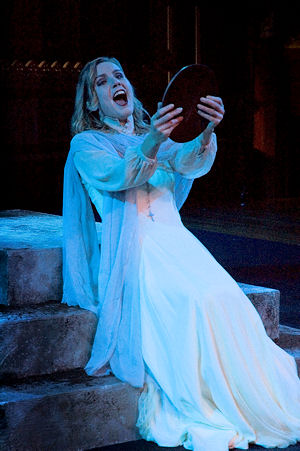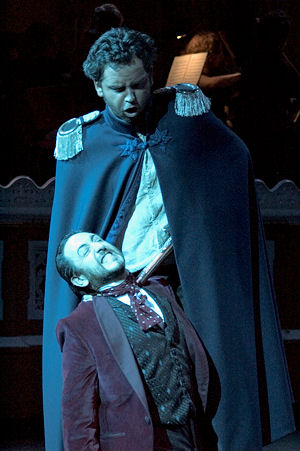Other Links
Editorial Board
- Editor - Bill Kenny
- London Editor-Melanie Eskenazi
- Founder - Len Mullenger
Google Site Search
SEEN
AND HEARD OPERA REVIEW
Donizetti,
Emilia Di Liverpool:
Opera
semiseria in two acts. Soloists, Chorus and Orchestra of the
European Opera Centre / Giovanni Pacor (conductor)
St, Georges Hall Liverpool to initiate the City of
Liverpool’s becoming the 2008
European
City of Culture 31.12. 2007 (RJF)
The presentation at

In 1957, in preparation for the 750th anniversary of
the award of the City Charter by King John, (the programme note
states, inaccurately, 700th) there was a search for
some appropriate artistic subject to illuminate the occasion. With
musicology a neglected study then, the Liverpool Music Group and
Fritz Spiegel delved into the musical archives on the lookout for
a theatrical piece with some conceivable bearing on
Liverpool.
They came up with Donizetti’s opera Emilia Di Liverpool and
a performance of the work; the first for nearly a century was
given on
12th
June 1957.
Emilia was Donizetti’s twelfth staged opera by 1824, or,
according to some commentators, his fifteenth or so. Historical
accuracy was not the name of the game for the Liverpool Music
Group, rather the discovery and the event. What was performed on
that 1957 occasion was Donizetti’s 1828 revision, properly titled
L’Ermitaggio di Liwerpool - take note of the spelling and
the use of the letter W. The librettist, like Donizetti, had not
much idea about Liverpool's location, describing it as
being in the mountains a few leagues north of London. In fact when
it comes to the detail of the libretto, particularly of the 1828
version, the name London is dominant over the use of
Liverpool. No matter, at least they made the Emilia’s father a sea
captain and owner of a vessel.
Both versions of the opera were for performances at
Naples’
small Teatro Nuovo, where the young Donizetti’s relationship with
the city had got off to a good start with his opera La Zingara
(The Gypsy Maiden) premiered there in May 1822. The requirements
of this small populist theatre were very specific: works would
involve musical items alternated with spoken dialogue, the latter
ideally suited to the resident comic bass, who spoke it in
Neapolitan dialect, and every opera for the Nuovo at this period
had to contain such a role. Also essential in a heavily censored
Naples was a happy ending; no matter the drama and near deaths and
threats that had gone on previously. This is so in both versions
of the Emilia opera, which, although having different cast
names, reflects essentially the same story.
This performance was from a new edition by French musicologist
Giles Rico, who has worked from all the available manuscripts in
Bergamo, Naples and Paris. Despite the failure of the 1824
version, Donizetti had high hopes for his creation and with a view
to performances in
Vienna
wrote some new numbers. When these performances failed to come
about Donizetti enlisted the support of Giuseppe Checcherini,
whose wife had sung at the Naples premiere, as librettist, and
revised the work. The revision was radical, involving the
removal of eight numbers and adding four new ones. Retitled
L’Eremitaggio Di Liwerpool the work was unfortunately no more
popular and lasted a mere six performances. Giles Rico has pruned
the extensive spoken dialogue and selected the best music from
both the 1824 and 1828 versions whilst keeping the coherence of
the story. Never performed in
Naples,
but included in these performances, is the lovely duet for Candida
and Emilia where the latter recounts her discovery that her father
is alive and has returned. This is Donizetti at his near romantic
best, as is much of the revised music, particularly compared with
that in Act I where Rossinian influence is more apparent. Giles
Rico’s version, with its restricted dialogue, made musical and
dramatic sense to me. Whether it will become the basis for a
meaningful fully staged resurrection of the work, at the Bergamo
Festival or elsewhere, remains to be seen.

Opera in the round and in such an intimate setting has its
particular challenges for the director and his team as well as for
the performers. With a simple set comprising Emilia’s mother’s
three tiered grave topped by a simple cross, and props limited to
a knife and pair of pistols, much depended on the acting ability
as well as the vocal strengths of the performers. Not all the
participating singers at this performance were wholly
inexperienced on the professional stage. Vincenzo Taormina in the
vital buffa role of Romualdo has already appeared at La Scala in a
routine revival (my words) of La Boheme as well as at
Italian Festivals in small roles. Romualdo is the role originally
written for the resident
Naples bass
who spoke the extensive dialogue in the city dialect, really more
an Italic language. A physically imposing man,
Taormina’s
strong baritone voice was appealing in tone and expressive, and
although he had not quite the natural acting ability of the true
buffa his was a convincing performance. As Federico, the
licentious villain of the piece, and unusually a tenor, Bruno
Camparetti had an appealing open and natural tone with a good
range of expression. He acted well, but occasionally over-pushed
his strong voice, unnecessarily given the size of the hall.
Camparetti and Taormina were particularly impressive in the
overtly Rossinian Act I duet. As Emilia’s father, Claudio, Cozmin
Sime from
Romania
had a well-coloured and covered tone and sang with a expressively
too. A little stiff in his acting, he could have been better
costumed, as his appearance here would not have kept Emilia in the
dark for very long guessing who he was. In the small role of the
Count, Etienne Hersperger who is currently completing studies in
Marseille, sang adequately and did his best to put character into
the part without really bringing over his supposed deafness which
is another important buffa aspect of the plot, particularly
the 1828 version.
All three female roles were well sung and acted. As Candida, I
found Christina Khosrowi’s low mezzo very appealing in tone and
range of colour both evident from the very opening of the opera
and making me particularly glad that her Act II duet with Emilia
was included in Giles Rico’s conflation. As Luigia, Romualdo’s
newly intended who flirts with Federico, Katrine Lavorel sang with
clearly enunciated lyric soprano tone. She moved and acted
well within the role’s limited opportunities. Limited opportunity
is not what comes the way of the eponymous role sung by the
Belgian lyric coloratura soprano Martine Reyners, and how! Hers
was a considerable vocal and histrionic achievement. Slim, even
slight, she sang strongly and acted with whole body conviction,
her eyes and arms being particularly communicative. Her voice is
strong and with a wide variety of colour across its considerable
range allied to vocal flexibility of a high order. Miss Reyners
produced a consummate performance that gave focus to the
whole of the action of the opera - its many and varied
emotional conflicts are burdened on Emilia. She concluded
the performance with hair-raising singing of the rondo finale from
the 1828 version and reminding me, at least, of Donizetti’s
Anna Bolena’s mad scene to come. I note from her programme
biography that she is down to sing Rosalinde and Tosca. I hope
these are in small theatres howeverm as her strong flexible voice
could easily be overstretched in the second of those roles. She
has the vocal and acting ability to make a fine Lucia. All the
soloists, and also the chorus who sat in the gallery, were
sympathetically and idiomatically supported by Giovanni Pacor’s
conducting and the sensitive playing he drew from the orchestra.
The staging by Ignacio Pian clarified the intricacies of the plot
very well indeed, as did the presence of surtitle translation of
the sung Italian.
The sparseness of the New Year’s Eve audience was perhaps
compensated by its quality. Sir Jeremy Isaacs, Chairman of the
Trustees of the European Opera Centre and sometime Intendant of
Covent Garden, as well as Sir Peter Moores, great supporter of
belcanto and rare opera, as well as Opera Rara, were among the
audience together with impresarios from other centres. They, like
me, enjoyed a well-presented and performed rarely heard work
which could gainfully be heard in larger centres now that the
belcanto revival is well under way. This version would be
ideal for the propagation of music that its composer thought to be
of merit beyond its initial reception at
Naples’s
Teatro Nuovo all those years ago. Liverpool is lucky to have its
name in the title and on this occasion the city did the name and
the opera the full justice it deserves.
Robert J
Farr
Pictures © Andrew Gale
